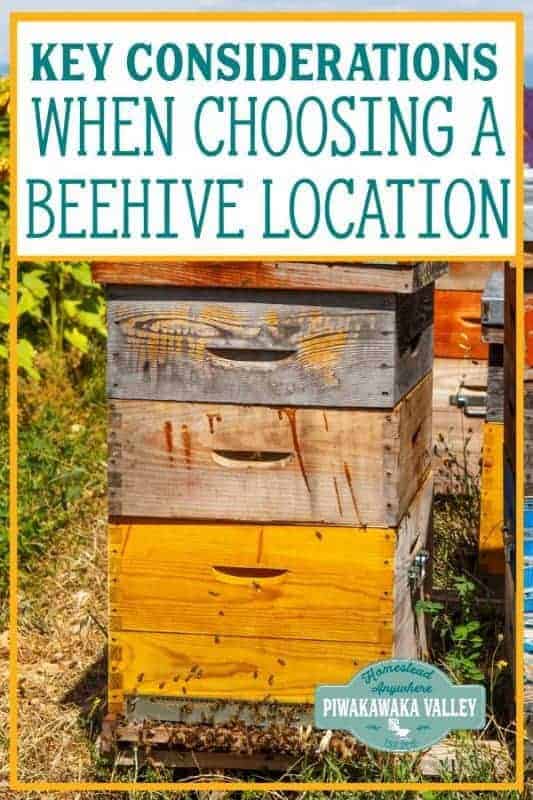This post was most recently updated on March 4th, 2020
If you are planning on keeping bees, you need to choose the location of your beehive carefully. A beehive can fit in to almost any location with some considerations. Be it the corner of a large garden, an orchard, an urban terrace or on your rooftop.
Please read: This information is provided for educational purposes only and is not intended to treat, diagnose or prevent any disease. We encourage you to make your own health care decisions in partnership with a qualified health care professional.
This post contains affiliate links, this means at no extra cost to you, we make a commission from sales. Please read our Disclosure Statement
Choosing the right location for your hive can be the difference in the health and happiness of both your neighbours and your bees!
7 Key Things to Consider when Choosing a Location for a Beehive
Once your hive has bees in it, you can move it, but it is much easier to get it in the right location in the first place.
RELATED: Top 5 animals to raise for profit
1 Consider your Neighbours
You hive’s location can affect your neighbours, especially if you live in a city.
Bees fly in a straight line at about head-height. You can see how this could quickly cause conflicts if your hive’s door is facing the neighbours!
You can encourage your bees to fly higher by adding a tall fence or hedge 3-6 feet from the hive entry.
If you are new to bees and are worried about the neighbours reactions, you can talk to them first, generally people are less likely to react badly if they know it is coming.
Of course, keeping the neighbours on side by sharing honey is always helpful too.
2 Consider Access to your Hive
Many laws require you to be able to walk right around your hive without obstacle.
This is to allow you and other inspectors easy access to all the hive to inspect and assess properly for Varroa mites and American Foul Brood.
It is your responsibility to arrange regular inspections from someone that is trained to know what they are looking for.
These illnesses are killing off our bees worldwide and need us all to help control and eradicate them.
RELATED: 40 Bee friendly plants
3 Exposure to the wind
Strong winds will knock your hives over, allow rain to blow in or remove your covers. Ideally your hives will be sheltered from the prevailing wind, and you should tie them down as an extra measure.
Place the hives on the lee side of the hill or beside a hedge.
Hive straps are designed to help secure your hive and stop them blowing down.
RELATED POST: Essential Beekeeping Equipment
4 Exposure to the sun
A bee hive is like one living organism, it needs its temperature to stay a fairly constant 35C/95F. How much sun your hive needs will depend on your local climate.
In colder areas placing the hive in full sun will help keep it warm, a hive can die of the cold in winter.
In hotter areas partial or full shade would be better, especially during the hot Summer months.
Sun on the hive early in the morning will wake up the hive and get them up and about to give plenty of time for gathering and making honey each day.
5 Moisture and Ventilation
Damp or flood prone ground is more likely to cause mold in the beehive. Position your hive on dry ground.
Too much moisture in the hive slows down the curing process of the honey and can increase the susceptibility to disease.
Placing your beehives on a pallet or raised wooden stand can improve air movement around and through the hive. Ideally your hives bottom board will also be ventilated to allow condensation to dissipate.
6 Flat and Firm Ground
Choose a site for your beehives that is a flat and firm area. Check that it doesn’t become a puddle or boggy mess during winter.
A soft or uneven surface makes it more likely that your beehives will sink and or tip over.
7 Near Water
Bees, like every other animal, need fresh water. They might be tiny, but they still need access to this crucial element.
DUring SUmmer they may crowd around water sources, drinking and taking it back to the hive for the other bees. If there is no natural water source near your bees, you will need to add one.
A large planter saucer filled with marbles or clean river stones and topped up with fresh water works well. Place the water right in front of the hive entrance as it is one of the first things they will look for when they leave the hive.
Choosing a Location for a Beehive
Once you have found the perfect spot for your hive, place it there and monitor it closely over the coming seasons. Don’t be afraid to move it if you notice your first choice is not idea.
Obviously, your bees will also need food. Make sure your garden is well stocked with bee-friendly flowers year-round.
Please Pin and Share!




